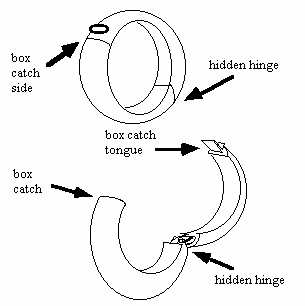All About Hidden Hinges
Hidden hinges are sometimes used on bracelets and jewelry pieces. I saw one on a Vietnamese bracelet once and have seen several on Diamonds International pieces. The place they pop up most frequently is in kitchen cabinets and doors on smooth surfaces like one sees on jet planes and sometimes on the sides of ships-hatches of various kinds. Look at these models because they are usually built to last and to be very sturdy. Kitchen cabinet hinges are a particularly fruitful resource.
2 Minute Read
Hidden hinges are sometimes used on bracelets and jewelry pieces. I saw one on a Vietnamese bracelet once and have seen several on Diamonds International pieces. The place they pop up most frequently is in kitchen cabinets and doors on smooth surfaces like one sees on jet planes and sometimes on the sides of ships-hatches of various kinds. Look at these models because they are usually built to last and to be very sturdy. Kitchen cabinet hinges are a particularly fruitful resource.
The Vietnamese bracelet's hidden hinge can serve as a generic model for jewelry. It should be noted that as with many fine mechanics one designs the piece first without regard as to how it will function and then one deals with the actual solution for the specific problem, so that every complex hinge and most fine catches differ in their details depending upon the actual piece itself. On fine jewelry every mechanic can be different a specific to the piece. This is why looking at models is so useful. You never know where an idea you saw somewhere will provide a solution to a technical and design problem you have.
The bracelet had a box catch on one side and on the opposite side where one expected to see the tubing ends of a hinge in only a single line or crack was visible. To use it one opened the catch, pulled slightly on the bracelet so that the hinge part slid out to the point that it could rotate, then it rotates open to allow one to insert the wrist and close it again.
Hidden hinges need to bend out of the way and usually withdraw into the body of the piece. They often involve the use of slides or double hinging in some manner. This one is constructed with a piece of thick sheet on one side. Through the end of the thick sheet is soldered a square hinge pin. On the other side are two pieces of strong sheet. They have slots in them and end in a round hole. When assembled the square hinge pin just fits in the slots and slides in and out of the body of the bracelet. When the square hinge pin reaches the round hole it can now rotate and so the hinge operates to swing the bracelet open. To close it one closes the bracelet and engages the box catch while at the same time the hinge slides back out of sight into the bracelet.
You assume all responsibility and risk for the use of the safety resources available on or through this web page. The International Gem Society LLC does not assume any liability for the materials, information and opinions provided on, or available through, this web page. No advice or information provided by this website shall create any warranty. Reliance on such advice, information or the content of this web page is solely at your own risk, including without limitation any safety guidelines, resources or precautions, or any other information related to safety that may be available on or through this web page. The International Gem Society LLC disclaims any liability for injury, death or damages resulting from the use thereof.
Charles Lewton-Brain
Master goldsmith Charles Lewton-Brain trained, studied and worked in Germany, Canada and the United States to learn the skills he uses. Charles Lewton-Brain is one of the original creators of Ganoksin.
The All-In-One Jewelry Making Solution At Your Fingertips
When you join the Ganoksin community, you get the tools you need to take your work to the next level.
Trusted Jewelry Making Information & Techniques
Sign up to receive the latest articles, techniques, and inspirations with our free newsletter.



